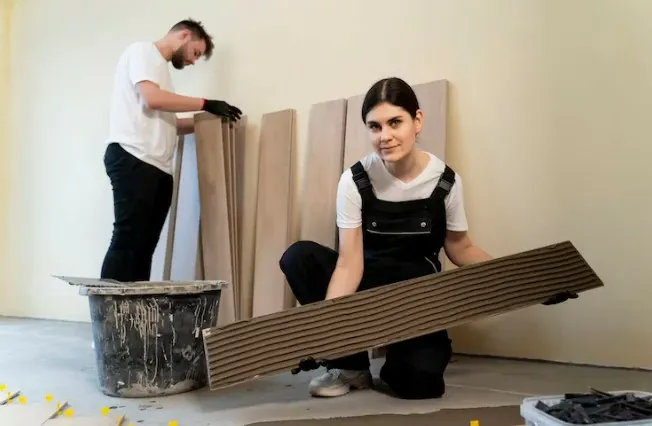Floor restoration is a common practice that homeowners undertake to bring back the beauty and elegance of their floors. However, like any renovation project, it comes with a cost. The question on many homeowners’ minds is how much they can expect to pay for floor restoration and whether it varies depending on the type of wood used in their flooring.
Several factors affect the cost of floor restoration, including the extent of damage or wear, the size of the space being restored, and the type of finish desired. Additionally, different types of wood have unique properties that impact their durability and response to various restoration techniques.
Understanding these factors can help homeowners make informed decisions about restoring their floors while staying within budget constraints. This article will explore how much one can expect to pay for floor restoration and whether it varies based on the type of wood used in flooring installations.
Factors that Affect the Cost of Floor Restoration
The cost of floor restoration is dependent on various factors such as the extent of damage, the type of wood, and the complexity of the project.
The extent of damage is a crucial factor since it determines the amount of work required to restore the floor. For instance, if your floor has deep scratches or stains that need sanding and refinishing, this will increase your overall costs. Additionally, if there are any structural issues with your subfloor or joists, these will need to be addressed before any restoration can take place.
Another factor that affects the cost of floor restoration is the type of wood used in your flooring. Different woods have different hardness levels which affect how they wear over time. Harder woods like oak or maple may require more effort to restore than softer woods like pine or birch. Furthermore, some exotic hardwoods may require special treatments or finishes which can add to their overall restoration costs.
Ultimately, it is essential to take into account all these factors when considering restoring your floors so that you can stay within budget while still achieving high-quality results.
Average Cost of Floor Restoration
On average, the cost of restoring a wooden floor can be influenced by several factors. The size and condition of the floor are important considerations that can affect the overall cost. Larger floors will require more time and effort to restore, while damaged or heavily worn floors may require additional preparation work before restoration can begin.
Another factor that can impact the cost of floor restoration is the type of wood being restored. Hardwoods such as oak and maple tend to be more expensive to restore than softer woods like pine or fir due to their durability and density. Additionally, exotic or rare woods will typically cost more to restore than common domestic species due to their limited availability and unique properties.
Other factors that can influence the cost include geographic location, contractor experience, and the level of customization desired by the client.
Is Floor Restoration Worth the Investment?
Investing in the restoration of a wooden floor requires careful consideration of various factors, including the longevity and aesthetic appeal that can be gained from such an investment.
While it may seem like a significant upfront cost, restoring a wooden floor can add value to your home and potentially save you money in the long run.
A restored wood floor can last for decades with proper maintenance, while also providing a timeless and classic look that can increase the overall appeal of your living space.
Furthermore, restored wooden floors are often more durable than newer ones due to their age and quality craftsmanship. This means that they are less likely to suffer from scratches or other forms of damage over time, reducing the need for costly repairs or replacements down the line.
Ultimately, whether or not floor restoration is worth the investment depends on your individual circumstances and goals, but it’s important to consider all of these factors before making any decisions.
Frequently Asked Questions
How long does the floor restoration process typically take?
The floor restoration process typically varies depending on the scope of work required and the type of wood involved. It may range from a few days to several weeks, but it is best to consult with a professional for an accurate estimate.
Can floor restoration be done on floors that have been previously treated with polyurethane?
Yes, floor restoration can be done on floors previously treated with polyurethane. However, the process may require additional steps such as sanding to remove the previous finish and achieve a smooth surface for refinishing.
How often do floors need to be restored?
Floor restoration frequency depends on traffic and maintenance. High-traffic areas should be restored every 3-5 years, while low-traffic areas can go up to 7-10 years. The cost of restoration varies depending on factors such as size, condition, and type of wood.
What are some common mistakes to avoid when restoring a wood floor?
Restoring wood floors requires skill and attention to detail. Common mistakes include improper sanding techniques, insufficient cleaning and preparation, and using the wrong type of finish. Avoid these pitfalls for a beautiful and long-lasting result.
Can floor restoration be done on engineered wood floors?
Engineered wood floors can be restored, but the amount of restoration possible depends on the thickness of the top layer. The cost varies depending on the extent of damage and the type of finish desired. A professional assessment is recommended to determine feasibility and cost.
Conclusion
In conclusion, the cost of floor restoration can vary depending on several factors such as the type of wood, the extent of damage, and the location. It is essential to note that restoring your floors is a worthwhile investment in the long run. Not only does it enhance your property’s value, but it also improves its aesthetic appeal.
However, if you are hesitant about spending money on floor restoration due to budget constraints or other reasons, there are alternative solutions such as DIY methods or opting for less expensive flooring options. Regardless of your decision, ensuring that your floors remain in good condition is crucial for maintaining a healthy living space and avoiding costly repairs in the future.
Ultimately, whether you choose to restore your floors or not depends entirely on your personal preferences and financial capabilities. Nevertheless, it is vital to weigh the pros and cons carefully before making a final decision.
Remember that taking care of your floors can go a long way in enhancing the overall look and feel of your home while also increasing its resale value.
The Importance Of Floor Restoration In Older Homes



